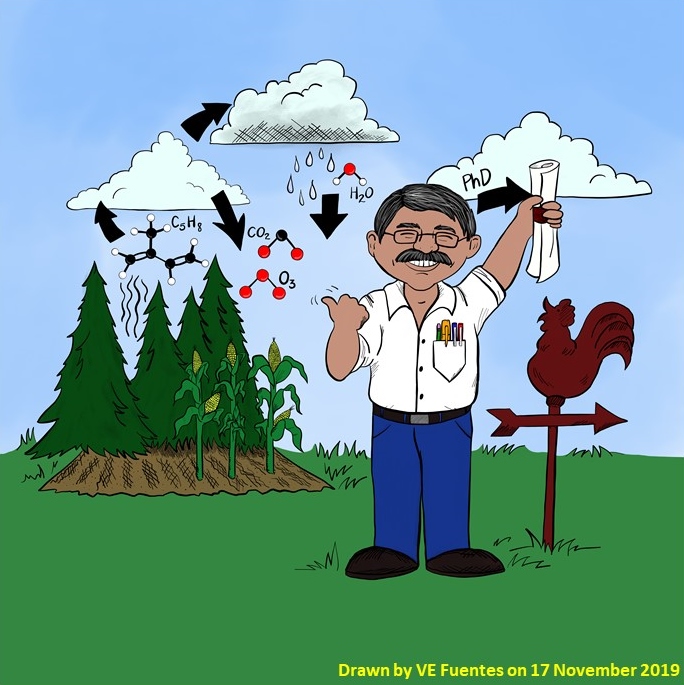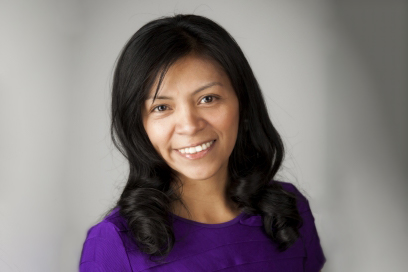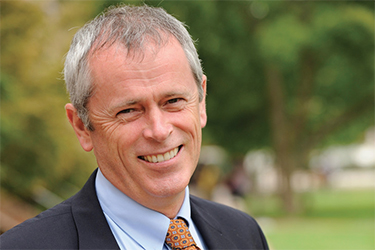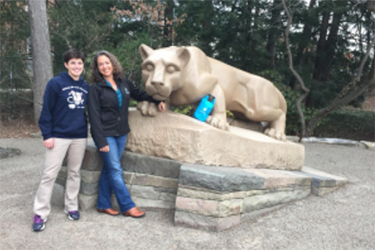Dr. Jose D. Fuentes, Professor of Atmospheric Science in the Department of Meteorology and Atmospheric Science
Dr. Jose D. Fuentes is a Professor of Atmospheric Science in the Department of Meteorology and Atmospheric Science at Penn State University. His research focuses on surface-atmosphere interactions and the impacts of climate change on ecosystems. He is also involved in the broadening participation of underrepresented groups, such as women, Native people, African Americans, and Hispanics in science and engineering. He is currently chairing the Committee on Equal Opportunities in Science and Engineering (CEOSE), which is a congressionally mandated committee to advise the National Science Foundation (NSF).
Why is sustainability important to you?
Sustainability is super important to me because of all the benefits that we derive from ecosystems and a clean environment. Ecosystems need to be preserved for future generations. We cannot and should never allow ecosystems and traditions that we all enjoy to be eliminated simply because we want to be selfish. Another element is to be mindful of using science to guide sustainability efforts. When we use facts, then we are guided by evidence, and no one should have any difficulties with implementing any approaches to preserve what we really like and enjoy.
Yes, I agree with that completely. I think that there’s been a trend of science mistrust in a lot of people recently, which is why I’m really interested in science communication. How do you think that the scientific community needs to respond to this growing, distressing problem?
It’s kind of tragic, to be honest with you. Even though here in the United States we enjoy a high degree of education among the population, we are now allowing politicians to be dismissive of facts and evidence. I think that’s going to be very dangerous. We rely so much on science in the technologies that we use on a daily basis, from computer science and engineering to good health care. We cannot simply go around and say, “Oh, those educated people are elitists.” That’s a very, very dangerous way of thinking that will not get us to a future where we will continue to enjoy the benefits of science and engineering.
I would say that scientists are very unique in our society because most scientists that I know are so busy doing their work. I don’t think that scientists have the time and resources that it takes to become good communicators of their own science. If I were a dean or a provost of a university, or a manager of a funding agency, I would require that scientists produce 1.5 pages describing the essence of articles that are published in plain language and share it with the public. So, if my fellow scientists were receptive to some advice, I would say that one activity that we can do is increase communication with the general public. I think we have many venues to do that. One of the issues with scientific publications is that we basically write for our own colleagues. Then, only our own colleagues understand what we do and what we learn. We don’t even write for other scientists who are in different fields. We are so specialized that we need a very specific audience to understand what we are doing in a given field. That’s why I think there is a need to have an outlet for the general public.
There is a need right now to become more proactive in terms of saying what we do and how the science that we generate is helping to sustain the wonderful lifestyle that we have in the United States. Why do you think a lot of people from around the world want to come to the United States? Because we have a very good standard of living. And that standard of living has been gained because of the advances that we have made in technology and science. That message is not being heard these days, unfortunately.
What drew you towards working with sustainability in your field?
From the early years of my profession, I have always thought about how my work can be applied. From the moment that I began to conceptualize a project, I’m always thinking, “how can I apply this research to address an environmental problem?” I have always been aware of that fact. I’m not just doing research simply because it’s a lot of fun to do research. I’m always thinking about how the research I do can be pragmatic. For instance, some of the work I have done is incorporated into numerical models that are used to predict air quality and models that anticipate the impacts of climate change. To me, that’s the result of the desire that I have to apply my discoveries in some form.
What sustainability projects have you worked on?
Well, I’m working on several projects, but I would say the most iconic project related to sustainability is about how both regional and global environmental change is driven by climate and how human activities are destroying certain elements of ecosystems. These days, I am focusing on studying how human activities are contributing to the decline of insect pollinators such as bumblebees and honeybees. The work I have done first illuminates the fact that when bees are trying to locate resources or food, they need to have some sort of an address telling them where the flowers are. That address is often conveyed through scents or fragrances that the flowers produce. Once the flowers vent these fragrances into the atmosphere, wind currents move those odors away from flowers, and bees can pick up those signals to find the address of the flowers. However, those molecules produced by the flowers are the most reactive gases that we have in the atmosphere. So, if these molecules are released in environments where we, humans, produce a lot of pollutants, these pollutants modify the characteristics of the molecules. By the time these modified molecules reach the bees, they don’t recognize them and can’t locate the flowers. In a way, the address has been blurred.
That’s only one of the many, many, numerous stresses that we are imposing on bees. Climate is at the center of all of this because the change in these scent molecules is driven by the amount of energy that resides in a given environment. Normally we use temperature as a proxy of energy, and increased energy means increasing these reactions. When we have atmospheric warming, we are accelerating the destruction of these molecules. So, there are many issues here at play. One issue is that we are putting a lot of air pollutants into the atmosphere which is confusing the bee population. Secondly, we are contributing to atmospheric warming, causing the reactions to happen more rapidly.
We are, in a way, creating an environment that is not only pernicious to bees but also harmful to us. Because if we don’t keep healthy insect pollinators, they will not pollinate the crops that we rely on. Bees contribute about 600 billion US dollars from the pollination of crops. This is not a little thing that is happening. This is a global phenomenon. This is not just in Pennsylvania or in New Jersey or New England, it’s everywhere. So, we first need to understand what is happening. Then secondly, we need to develop strategies to ensure that we do something about that.
What are the pollutants that alter the signatures of the flowers and where do they come from?
One of the most common air pollutants is the ozone molecule. The ozone molecule is comprised of three atoms of oxygen. Ozone in the lower atmosphere is produced via chemical reactions involving nitrogen oxides that are produced through combustion. In engines, such as in our cars, we produce a molecule that we call nitric oxide, which reacts with ozone to produce nitrogen dioxide. These nitrogen oxide molecules, the ozone molecules, are interacting in air masses where we have the flowers, destroying the scents.
Another pollutant is called hydroxyl. We have plenty of that around the big cities. However, these molecules don’t just reside where the primary polluting entities are, the atmosphere moves these pollutants around the world. The heavy industrialization that is taking place in Asia is producing a lot of the pollution, then the air masses travel across the ocean and end up in the continental United States. So that’s how serious it has become.
What do you think the United States and the rest of the world need to do to help fix this problem?
First of all, we really need to continue working hard to reduce emissions in the United States. We have to some degree achieved success in doing that, but we need to do more. There are some glimmers of hope; people are now thinking about switching to electric vehicles as opposed to fossil fuel-based vehicles. Relying less on the burning of coal or natural gas to produce electricity will also help. My own view is that here in the United States, we know the science and we know what to do. My desire is that we should be leaders. We should set examples for the rest of the world to achieve sustainability. We can do it. We have the science. I think it is the political will we mostly need to work on.
What does a sustainable society look like to you?
It means that we don’t have to keep surviving in our society in a manner that depletes resources. We shouldn’t be that selfish, in my opinion. We need to keep in mind that there are ways for us to live in a very sustainable manner. To me, the key concept there is the depletion of resources. Particularly, there are some resources that if we can keep exploiting them may not be there for future generations. We already have examples of resources that we have almost exploited to the level of extinction.
What work do you do with the Committee on Equal Opportunities in Science and Engineering that you are the chair for?
Before I answer that question, you need to understand that sustainability and human health are intrinsically related. So, if we are promoting sustainability and if we practice sustainability, we are almost bound to have healthier societies.
I have been working for several years now with this congressionally mandated committee at the National Science Foundation (CEOSE: Committee on Equal Opportunities in Science and Engineering). Our main function is to appraise what the National Science Foundation is doing in terms of promoting the participation of women and under-represented groups in science and engineering. Now, in this country, women represent almost 51% of the population, according to the 2020 census. So why do we have so few women in science and engineering? We need to identify and then remove all the barriers that prevent people from participating in science and engineering. I have a colleague, the former director of the National Science Foundation, who says, if science and engineering were akin to playing a sport, that, from the start of the game, we are excluding 51% of the players. We cannot win the games if part of the team is excluded.
As part of CEOSE, we offer recommendations to Congress. Then two congressional committees review our recommendations. One is the Senate (Commerce). Then, in the house, we have the Committee on Science and Technology. Those two committees review our recommendations and send them back to the Director of the National Science Foundation. There is a bit of accountability there because if we say, for example, we need to promote more leaders that come from under-represented groups such as African-Americans, Native Americans, Hispanic Americans, and women, then the NSF director has the responsibility to act on those recommendations. We now have several examples that show how these recommendations are being implemented. But we still have a long way to go. I have been Chair of this committee for the last four years. We have some reports; we have produced some initiatives, but we don’t see the numbers changing at the pace that some of us would like to see.
In fact, during the pandemic, an unprecedented number of women left the STEM workforce. Normally, in this country, about 17% of the stem workforce is women. Now, is more like 13/14% because of the pandemic. We need to remove barriers to women becoming successful professionals. That would be things like maternity leave, and childcare, and I can go on and on with the list. But we have a lot of barriers, believe it or not. We need to have a full team here in science and engineering.
Yes, there are also cultural barriers, such as women and minority groups being treated differently in STEM or feeling like their voices are ignored.
That culture has to change. The irony is that some people fail to recognize the value of being more inclusive. I can tell you that we are missing a lot of talented colleagues from women’s groups, African Americans, Hispanic males, and Native People. Right now, our society is structured in such a way that barriers still prevail. My job throughout my professional life has always been to work to ensure that those barriers are not there. I’ve been working lately with the US Government Accountability Office as well as NSF. I am very motivated to work in that area. Because I come from a community of citizens where we are not meaningfully represented in any branch of science. For example, look at the Agricultural Science School here at Penn State. We have very few Hispanics in the faculty. However, a high percentage of the workforce in the agriculture sector in the US is Hispanic. They are the workers, the people who harvest the crops. But at the professional level, the representation is not there.
What can people in fields of science and universities do better to represent Hispanics?
First of all, remove all the barriers. Don’t think that the reason we have no Hispanics represented in one of the largest schools in the country is that Hispanics are not interested in agriculture. It’s because you have a place that is not really welcoming to those individuals. This really needs work. And if no one works on that, that reality will prevail for many years to come. So, you have to go out, you have to reach out to these communities and say, “no, we’re changing, we’re going to change. We’re going to welcome you here and you’re going to be part of our community.” We don’t have that kind of attitude right now.
How do you think Penn State is doing with remedying this?
Let me be blunt with you. I’ve been here many years and that’s not been my experience. Others may have a different experience, but I always like to ask for evidence and facts to contradict what I am seeing. I would definitely challenge them to do better. Penn State should honor its commitments to serve the Commonwealth of Pennsylvania and the Nation. We are supposed to make sure that African Americans, Hispanic Americans, Native Americans, and women have access to science and engineering. But that’s not the case right now. Only 2.6% or so of our faculty is Black. And we’re losing them all the time. If I were to manage this university, I will go out of the way to ensure that we don’t lose any Black faculty members. In fact, I will go anywhere in the country to recruit them, because the state of Pennsylvania is approximately 12% African American. We don’t have anything close to that represented in our faculty. It doesn’t matter what angle you tackle this problem from, the angle of fairness, the angle of competitiveness, the angle of having a very diverse workforce, because we need representation in this science and engineering in this country. We don’t have those sentiments here.
Since some of your work has led to working with communities in South America, and other Hispanic populations, how do you think those populations are affected by climate change and atmospheric change?
Disproportionally and perniciously, and affected by the whole suite of reasons. When I was a faculty member at the University of Virginia for nearly 14 years, I was working a lot with these concepts because, in that region of Central Virginia, power plants would be placed in the poorest communities and the poorest counties in order to circumvent environmental regulations. The counties that couldn’t afford lawyers are the ones that inherited those facilities. Sadly, I have to say, it is not just in the United States. This is a global issue. The work I do in Panama, Colombia, Peru, and Brazil is the same. Everywhere, the most humble communities are the ones that are being impacted in the most direct way by all the extreme events that climate change has generated. I have been asked to speak at the United Nations in September on that issue, but to give the talk in Spanish, because this is a universal problem, not just in American or English. I think it’s even more acute in places such as Latin America. You have to realize that some of these countries don’t have many environmental regulations. At least here, in the United States, we can say, oh yeah, the problem is happening in this neighborhood in Baltimore or Philadelphia, right? But down there, in South America, they sometimes don’t have the scientific resources to appraise their impacts.
I’ve been working in the southern fringes of the Amazon rainforest in the state of Rondônia, Brazil, which is the state bordering Bolivia. Working in the central and southwestern parts of the Amazon. But again, we don’t have rules in place to protect the rainforest. And when we, from the outside, tell those countries that we need to preserve the rainforest because it plays a unique role in the Earth’s climate system, we get pushback. I think that the perspective of global citizenship is not there. That’s missing these days. I think that climate change is impacting everybody, whether we are responsible for the change yet or not. I think that someone has to come along and say, we have to work collectively to address this issue. There had been some attempts to do that, but very sadly, the most wealthy and powerful countries tend to derail this.
So, imagine that it’s 20 years in the future and our communities have become more sustainable and resilient. What will we need to do to achieve that? For the world and at Penn State?
First of all, I would like to see that Penn State takes seriously its core mission. And its core mission is to educate and train the future workforce in this country. Right now, Penn State is not doing that. Penn State tends to cater to the needs of one community, the white community. I would invest a lot of resources to ensure that the core mission is implemented. I would reach out to all the communities in the state of Pennsylvania. I would not just focus on one individual or one group, regardless of whether they are the most numerous or not. I would focus on the entire community all over the state so that we can have a diverse community on the university campus. We need to be more inclusive in everything we do. If we don’t do that, then this university and our ideas will become esoteric.






